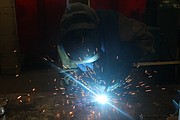Plains Shop Class opens new doors for students
There are many paths for a person to take in their life after high school, aside from college.
Today, it has become the norm to graduate high school and to continue one’s education, and we are often told that this is the best path. For some it may be, however many of the schools in Sanders County, including Plains High, are presenting students with another option. This “other option” also happens to come with college credits as a bonus.
Plains High is working together with the Flathead Valley Community College to give students an alternative to traditional college. Students interested in this opportunity can enroll in one of several shop classes including metals, Computer-Aided Designs (CAD) and woodwork.
Metal work, in particular, covers a vast array of applications and practices in regard to working with various steels, copper and aluminum. Some of these applications include welding, forging and plasma cutting. Students who participate get the change to earn real world training in these and many more skills that they can directly use right out of high school.
The average college graduate completes school with thousands of dollars in debt and no definite path into the future or with a stable lucrative career. Often people who go in to work trade jobs avoid the debt and can make up to more than $60,000 a year in a trade job. These jobs are stable, lucrative and are so needed in today’s society that many companies are giving jobs away.
A student who has taken any form of technical training then becomes invaluable in the industry. Since so many high school graduates are moving into college, and the baby boomer generation who worked technical and trade-type jobs are retiring, there is a massive influx in the job market.
Students can take advantage of this influx with the ability to set up a bright future working with their hands. This is one of the many principles taught in the Plains’ Shop classes.
The shop teacher, Kyle Mitchell, explains how students take this path after school, saying “a few go on to use it for a couple of years, however many are here for the college credits.”
He is correct, one of the main draws to taking the shop classes are that juniors and seniors can also sign up to earn college credits that are valid state-wide. This opportunity is given by the College, and high school students can sign up online, as if they were enrolled, to make progress on their future transcript.
Students can earn up to six credits a year, three in CAD and up to eight in welding and metals. These credits are not just applicable in traditional college, however, and can even help students wanting to further their education in technical and trade schools, especially with metals class.
Mr. Mitchell teaches two metals classes a day and many of his students are part of the dual credit program.
“It pulls kids into welding,” Mitchell said.
Each class a student takes can earn them anywhere from two to three credits and there are two levels in the metal work class.
In the first year, students take the basic course, learning safety, how to work the machines and equipment, as well as the basics of welding.
Second-year students partake in welding theory training and get to put more time into their practice. They also practice and get ready for testing and have the ability to get officially certified.
In the U.S., people who weld have to recertify at every new place they work, however having the certification on one’s resume can be an extreme boost to a career.







